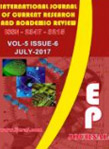Abstract Volume:5 Issue-6 Year-2017 Original Research Articles
 |
Online ISSN : 2347 - 3215 Issues : 12 per year Publisher : Excellent Publishers Email : editorijcret@gmail.com |
The research study evaluates the potential of Sorghum bicolor for development of mycorrhizal soil. The development of soil based mycorrhizal inoculum using sorghum bicolor was carried out under controlled greenhouse conditions. The experiment was carried out for a period of two and half months. The physico-chemical parameters and mycorrhizal characterization such as root colonization and spore count was carried out at regular interval. Significant increase in spore count was observed during the development of mycorrhizal soil. The Sorghum bicolor grown in mycorrhizal soil had higher root colonization (%) as compare to control soil. The spore count was found to be increasing from 16 of 100 g -1 to 526 100 g -1 and root colonization from 3 % to 80% of mycorrhizal soil when compared to control soil. Root colonization in the mycorrhizal soil was positively correlated (P<0.001) with spore count. The response of mycorrhizal characteristics such as root colonization and spore count to physic-chemical parameters such as pH, carbon content, moisture, phosphorous and nitrogen was analysed. Soil moisture had a positive influence on root colonization and spore count, while phosphorous was negatively correlated with root colonization and spore count. Mycorrhizal soil showed a significant positive correlation between root colonization and spore count with nitrogen and organic carbon. Thus development of mycorrhizal soil induces series of changes in soil physico-chemical characteristics and nutrient availability that may determine outcome of rhizosphere bioremediation. The development of effective mycorrhizosphere in the present research study can provide a suitable environment for enhanced degradation of organic pollutants in soil.
How to cite this article:
Jyoti Fulekar, Bhawana Pathak and Fulekar, M.H. 2017. Development of Mycorrhizosphere Using Sorghum bicolor for Rhizosphere BiormediationInt.J.Curr.Res.Aca.Rev. 5(6): 42-48doi: https://doi.org/10.20546/ijcrar.2017.506.006



Quick Navigation
- Print Article
- Full Text PDF
- How to Cite this Article
- on Google
- on Google Scholor
- Citation Alert By Google Scholar
